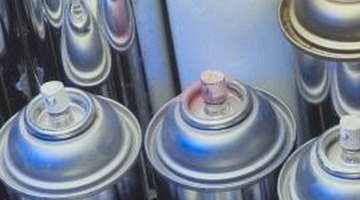Aerosol Paint Ingredients
Aerosol or spray paint is produced to provide a simple way of applying paint to a surface without the need for separate tools, such as brushes or rollers. The aerosol can was developed to dispense various substances including insect repellants, drinks and paint.
History

The development of aerosol spray cans can be traced back to the development of carbonated drinks in France in the 18th century, which were dispensed from metal cans. The development of various valves continued until in 1899 Helbling and Pertsch added propellants to force the substance within the can out, the initial chemicals used were methyl and ethyl chloride. The aerosol can invention was completed by the U.S. Army in an attempt to reduce the instances of members of the armed forces being infected by disease from airborne insects on deployment during the World War II. The aerosol can was developed as a system of spraying insect repellant onto the skin to deter disease carrying insects.
Ingredients
Each type of paint contains four main ingredients, which are solvent, binder, pigment and additives. The solvent is added to the paint as a liquid used to carry the components of the paint from its container, in aerosols the solvent is used to maintain the consistency of the paint as it is sprayed from the can. The solvent can either be water based or a form of organic solvent. The binder is used within the liquid paint to enable the process of hardening and production of the hard film that remains when the solvent has evaporated. Solid particles make up the pigment that gives the paint its color and opacity. Finally, additives are added to a can of aerosol paint to increase certain properties of the paint, which can include storage time, application and production qualities.
Propellants
In order to release the paint within an aerosol can a propellant must be added to the container that expands and forces the paint out of the can when the valve is opened. Initially, the chemicals used as propellants for aerosol paint cans were chlorofluorocarbons, that were banned in 1978 as they were discovered to destroy the protect ozone layer in the Earth's atmosphere. The next type of propellant that was introduced into aerosol spray cans were propane and butane, which were later abandoned as they contributed to the build up of smog around the planet in the 1980s. In 2011, aerosol spray cans contain hydro fluorocarbons, such as Difluoroethane and Tetrafluororethane that are friendlier to the environment.
Waste
Used aerosol paint cans are usually classified as hazardous waste because of the amount of ingredients that remain in the can following the release of contained paints. In order to release the residual ingredients contained within spray aerosols the can must be punctured, leading to increased air emissions and other hazards.
References
Writer Bio
Paul Cartmell began his career as a writer for documentaries and fictional films in the United Kingdom in the mid-1990s. Working in documentary journalism, Cartmell wrote about a wide variety of subjects including racism in professional sports. Cartmell attended the University of Lincoln and London Metropolitan University, gaining degrees in journalism and film studies.
Photo Credits
- Hemera Technologies/AbleStock.com/Getty Images
More Articles



